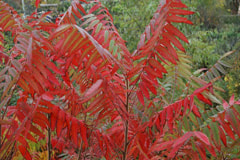|
I am already missing the stand of staghorn sumac that was growing on the road near my house here in Maine. This time of year I look to the ornamental sumac groves for the first signs of fall. These small trees turn the most exquisite sun yellow, deep orange and flaming red as the season progresses as well as providing the birds with clusters of dark red berries that evening grosbeaks, northern cardinals, ruffed grouse, turkeys, robins, chickadees, woodpeckers, and others feast on throughout the coming winter and spring. Deer, elk, and moose browse on the leaves and twigs. Some butterflies use this food to feed their young and sumacs provide nectar for bees and other beneficial insects while providing great shelter for many more wild creatures.
In Maine many consider these small trees a nuisance but elsewhere, like in New Mexico, the plant is sold and grown for its vibrant color. I don’t know how many folks know that this plant is so beneficial to wildlife. The staghorn sumac is just one of many sumacs that are found all over the world, and most look similar. This large shrub has compound leaves, meaning each leaf is composed of several leaflets. Eleven to thirty plus leaflets are arranged in opposite pairs along a stem which droops gracefully towards the ground. The leaves are toothed along the edges, the branches fuzzy. Clumps of small greenish flowers are inconspicuous but form an upright cone that yields red berries by late summer. Sumacs are not fussy about growing requirements and thrive in open places, hillsides, along the edges of pine forests and country roads all throughout the northeast. There are some species that are well adapted to desert areas because they are particularly drought tolerant. Sumacs control erosion because they have shallow roots. They like to grow in groves to develop complex root systems that support the whole group. One cousin is poisonous. This sumac can easily be identified even if it looks similar to other sumacs because of its penchant for swamps and other wet places. It likes to have its feet in water. This species has a thick trunk and sturdy branches; it produces sprays of drooping smooth white berries in the fall. The plant can cause an unpleasant rash. Humans have enjoyed sumac berries, which have a zingy lemon taste when picked at their peak, typically in late summer or early fall. They are packed with vitamin C. Soak berries in hot or cold water and then strain to make a refreshing drink or a gargle for sore throats. If the drink is too sharp for your taste buds, add a little maple syrup. Other sumac parts have been used in a variety of ways: fresh sumac stems have been used in basket weaving, the tannin-packed leaves and bark have been used for tanning leather and the roots have been made into teas that help stop bleeding. The leaves and berries are used to make dyes. The trees have multiple trunks and pithy, hollow stems. The wood is good for many things, including whittling, making pipe stems and making a natural “tap” for collecting maple syrup from a tree. Unlike poison sumac, ornamental sumac brush can be safely burned, and the smoke can be used by beekeepers to calm the bees during hive maintenance. Ornamental sumacs are highly adaptive, and there are different types for every region of the United States and Canada. Sumacs are also imported from other parts of the world and naturalized in North America. Another advantage is that they appear to be impervious to many plant diseases. Once established they spread easily. It wasn’t until I lived in New Mexico that I thought of them as a garden addition because there are so many varieties growing wild around here.
0 Comments
|
Submit your ideas for local feature articles
Profiles Gardening Recipes Observations Birding Essays Hiking AuthorsYou! Archives
October 2025
Categories
All
|

 RSS Feed
RSS Feed